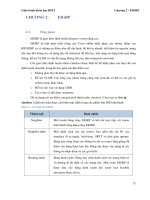Giao thức định tuyến - Chapter 2 ppsx
Bạn đang xem bản rút gọn của tài liệu. Xem và tải ngay bản đầy đủ của tài liệu tại đây (3.37 MB, 64 trang )
Static Routing
Routing Protocols and Concepts – Chapter 2
© 2007 Cisco Systems, Inc. All rights reserved. Cisco Public
ITE PC v4.0
Chapter 1
1
Objectives
D
e
fin
e
th
e
ge
n
e
r
a
l r
o
l
e
a
r
ou
t
e
r
p
l
ays
in n
e
tw
o
rk
s
.
e e e ge e a o e a ou e p ays e o s
Describe the directly connected networks, different
router interfaces
router
interfaces
Examine directly connected networks in the routing
table and use the CDP protocol
table
and
use
the
CDP
protocol
Describe static routes with exit interfaces
Describe summary and default route
Examine how packets get forwarded when using
static routes
Identify how to manage and troubleshoot static routes
ITE PC v4.0
Chapter 1
2
© 2007 Cisco Systems, Inc. All rights reserved. Cisco Public
General Role of the Router
F
u
n
c
ti
o
n
s
o
f
a
R
ou
t
er
ucosoa oue
Best Path Selections
Forwarding packets to destination
Routers perform packet forwarding by learning about
remote networks and maintainin
g
routin
g
information.
gg
– The routers primary forwarding decision is based on Layer 3
information, the destination IP address.
–
The router's routing table is used to find the best match
between the destination IP of a packet and a network address
in the routing table.
– The routing table will ultimately determine the exit interface to
forward the packet and the router will encapsulate that packet in
the appropriated data link frame for that outgoing interface
ITE PC v4.0
Chapter 1
3
© 2007 Cisco Systems, Inc. All rights reserved. Cisco Public
the
appropriated
data
link
frame
for
that
outgoing
interface
.
General Role of the Router
Intr
oduc
in
g
th
e
T
opo
l
ogy
oduc g e opo ogy
– The figure shows the topology used in this chapter.
– 3 1800 series routers connected via WAN links
– Each router connected to a LAN represented by a switch and a PC
ITE PC v4.0
Chapter 1
4
© 2007 Cisco Systems, Inc. All rights reserved. Cisco Public
General Role of the Router
Connections of a Router for WAN
-A router has a DB-60 port that can support 5
different cabling standards
–
Newer routers su
pp
ort the smart serial
pp
interface that allows for more data to be
forwarded across fewer cable pins.
Connections of a Router for Ethernet
-2 types of connectors can be used: Straight
through and Cross-over
Straight through used to connect:
Straight
through
used
to
connect:
-Switch-to-Router, Switch-to-PC, Hub-to-
PC, Hub-to-Server
Cross
-
over used to connect (pin 1 connected
Cross
-
over
used
to
connect
(pin
1
connected
to pin 3, and pin 2 connected to pin 6):
-Switch-to-Switch, PC-to-PC, Switch-to-
Hub
,
Hub-to-Hub
,
Route
r
-to-Router
,
PC-
ITE PC v4.0
Chapter 1
5
© 2007 Cisco Systems, Inc. All rights reserved. Cisco Public
,
,
,
Router
General Role of the Router in COD
S
m
a
rt
Se
ri
a
l
cab
l
es
: D
C
E
a
n
d
DTE
S a Se a cab es C a d
-Use straight cable to connect between
the DTE and DCE
DCE and DTE Adapter
Ethernet cables:
Cross-over cable: RED cable
Roll-over cable:
flat cables
Straight cable: all other cables
/>ITE PC v4.0
Chapter 1
6
© 2007 Cisco Systems, Inc. All rights reserved. Cisco Public
Serial Connectors
DTE
DCE
DCE
DTE
DTE
DCE
DTE
DTE
DCE
In our labs we will use serial DTE/DCE cables (no
CSU/DSU) with a DTE cable connected to one router and
DCE bl t d t th th t
ITE PC v4.0
Chapter 1
7
© 2007 Cisco Systems, Inc. All rights reserved. Cisco Public
a
DCE
ca
bl
e connec
t
e
d
t
o
th
e o
th
er rou
t
er.
Interfaces
Ex
a
minin
g
R
oute
r In
te
rf
aces
a g oute te aces
-Show IP router command – used to view routing table
-Show Interfaces command – used to show status of an interface
-Show IP Interface brief command – used to show a portion of
the interface information on a condensed format
Sh i
fi
d
dt h fi ti
-
Sh
ow runn
i
ng-con
fi
g comman
d
–
use
d
t
o s
h
ow con
fi
gura
ti
on
file in RAM
ITE PC v4.0
Chapter 1
8
© 2007 Cisco Systems, Inc. All rights reserved. Cisco Public
Interfaces
Co
nfi
gu
rin
g
a
n E
t
h
e
rn
et
in
te
rf
ace
Co gu g a t e et te ace
-By default all serial and Ethernet interfaces are down
-To enable an interface use the No Shutdown command
•The show ip route
command is used to
display the routing table.
•Initially, the routing table is
empty if no interfaces have
bfid
b
een con
fi
gure
d
.
•Static routes and dynamic
routes will not be added to
th ti t bl til th
th
e rou
ti
ng
t
a
bl
e un
til
th
e
appropriate local interfaces
have been configured on
the router
ITE PC v4.0
Chapter 1
9
© 2007 Cisco Systems, Inc. All rights reserved. Cisco Public
the
router
.
Verifying Ethernet interface
Verifying
Ethernet
interface
- Show interfaces - command shows the status and gives a detailed
descri
p
tion for all interfaces on the route
r
p
– Show interfaces fastEthernet 0/0 – command used to show status of
fast Ethernet port
R1#show interfaces fastethernet 0/0
•
R1#show
interfaces
fastethernet
0/0
•FastEthernet0/0 is administratively down, line protocol is down
• Administratively down means that the interface is currently in the shutdown mode, or turned off.
•
Line protocol is down
means in this case that the interface is not receiving a carrier signal from
•
Line
protocol
is
down
means
,
in
this
case
,
that
the
interface
is
not
receiving
a
carrier
signal
from
a switch or the hub. This condition may also be due to the fact that the interface is in shutdown
mode
• You will notice that the show interfaces command does not show any IP addresses on R1's
interfaces The reason for this is because we have not yet configured IP addresses on any of the
interfaces
.
The
reason
for
this
is
because
we
have
not
yet
configured
IP
addresses
on
any
of
the
interfaces.
ITE PC v4.0
Chapter 1
10
© 2007 Cisco Systems, Inc. All rights reserved. Cisco Public
Interfaces
Interfaces
Verifying Ethernet interface
–
Show run
–
Show
run
• command displays the current configuration file that
the router is using. Configuration commands are
temporarily stored in the running configuration file
and implemented immediately by the router
and
implemented
immediately
by
the
router
.
•However, using show running-config is not
necessarily the best way to verify interface
configurations.
-Show ip interface brief –
-can be used to see a portion of the interface
information in a condensed format.
ITE PC v4.0
Chapter 1
11
© 2007 Cisco Systems, Inc. All rights reserved. Cisco Public
Configuring an Ethernet interface
Configuring
an
Ethernet
interface
By default, all router interfaces are shutdown. To enable this
interface, use the no shutdown command, which changes the
interface from administratively down to up
interface
from
administratively
down
to
up
.
R1(config)#interface fastethernet 0/0
R1(config-if)#ip address 172.16.3.1 255.255.255.0
R1(config-if)#no shutdown
The following message is returned from the IOS:
*Mar 1 01:16:08.212: %LINK-3-UPDOWN: Interface
FastEthernet0/0, changed state to up
*Mar 1 01:16:09.214: %LINEPROTO-5-UPDOWN: Line
p
rotocol on Interface FastEthernet0/0
,
chan
g
ed state to u
p
p,
gp
–The first changed state to up message indicates that,
physically, the connection is good. If you do not get this first
messa
g
e
,
be sure that the interface is
p
ro
p
erl
y
connected to
g, p p y
a carrier signal from switch or a hub.
–The second changed state to up message indicates that the
Data Link layer is operational.
•
However WAN interfaces in a lab environment require
ITE PC v4.0
Chapter 1
12
© 2007 Cisco Systems, Inc. All rights reserved. Cisco Public
•
However
,
WAN
interfaces
in
a
lab
environment
require
clocking on one side of the link. If you do correctly set the
clock rate, then line protocol will not change to up.
Configuring an Ethernet interface
Configuring
an
Ethernet
interface
Unsolicited Messa
g
es from IOS
g
The IOS often sends unsolicited messages.
As you can see in the figure, sometimes these
messages will occur when you are in the middle
messages
will
occur
when
you
are
in
the
middle
of typing a command, such as configuring a
description for the interface.
–The IOS message does not affect the command,
but it can cause you to lose your place when typing.
In order to keep the unsolicited output separate
In
order
to
keep
the
unsolicited
output
separate
from your input, enter line configuration mode
for the consoled port and add the logging
synchronous command, as shown. You will see
that messages returned by IOS no longer
that
messages
returned
by
IOS
no
longer
interfere with your typing.
ITE PC v4.0
Chapter 1
13
© 2007 Cisco Systems, Inc. All rights reserved. Cisco Public
Interfaces
Interfaces
Verifying Ethernet interface
-Show interfaces fastEthernet 0/0
Reading the Routing Table
–Now look at routing table shown in the figure.
Notice R1 now has a "directly connected"
FastEthernet 0/0 interface a new network.
–The interface was configured with the
172.16.3.1/24 IP address which makes it a
member of the 172.16.3.0/24 network.
172.16.0.0/24 is subnetted, 1 subnets
C 172.16.3.0 is directly connected, FastEthernet0/0
–The C at the beginning of the route indicates
that this is a directly connected network. In other
words, R1 has an interface that belongs to this
network
network
.
–The /24 subnet mask for this route is displayed
in the line above the actual route.
ITE PC v4.0
Chapter 1
14
© 2007 Cisco Systems, Inc. All rights reserved. Cisco Public
Interfaces
Interfaces
Reading the Routing Table
172.16.0.0/24 is subnetted, 1 subnets
172.16.0.0/24
is
subnetted,
1
subnets
–Having a single route represent an entire
network of host IP addresses makes the
network
of
host
IP
addresses
makes
the
routing table smaller, with fewer routes,
which results in faster routing table
lookups.
•
It means that this route matches all
•
It
means
that
this
route
matches
all
packets with a destination address
belonging to this network.
–The routing table could contain all 254
idiid lh tIP dd f th
i
n
di
v
id
ua
l
h
os
t
IP
a
dd
resses
f
or
th
e
172.16.3.0/24 network, but that is an
inefficient way of storing addresses.
ITE PC v4.0
Chapter 1
15
© 2007 Cisco Systems, Inc. All rights reserved. Cisco Public
Interfaces
Interfaces
Verifying Ethernet interface
show interfaces fastethernet 0/0
show ip interface brief
The show interfaces fastethernet 0/0 command
in the figure now shows
in
the
figure
now
shows
–The interface is up, and the line protocol is up.
The no shutdown command changed the
interface from administratively down to up.
–
Notice that the IP address is now displayed.
The command show ip interface brief in the
figure shows that the interface is up, and the
li t l i (
iddft
)
li
ne pro
t
oco
l
i
s up.
(
i
n a con
d
ense
d
f
orma
t
)
Typically, the router's Ethernet or FastEthernet
interface will be the default gateway IP address
for any devices on that LAN
for
any
devices
on
that
LAN
.
–For example, PC1 would be configured with a
IP address belonging to the 172.16.3.0/24
network, with the default
g
atewa
y
IP address
ITE PC v4.0
Chapter 1
16
© 2007 Cisco Systems, Inc. All rights reserved. Cisco Public
gy
172.16.3.1.
–172.16.3.1 is router R1's FastEthernet IP
address.
Ethernet Interfaces Participate in ARP
Ethernet
Interfaces
Participate
in
ARP
A router's Ethernet interface participates
in a LAN network just like any other
device on that network
device
on
that
network
.
–This means that these interfaces have a
Layer 2 MAC address, as shown in the figure.
The show interfaces command displays the
MAC dd f th Eth t i t f
MAC
a
dd
ress
f
or
th
e
Eth
erne
t
i
n
t
er
f
aces.
–If a router has a packet destined for a
device on a directly connected Ethernet
network
,
it checks the ARP table for an entr
y
,y
with that destination IP address in order to
map it to the MAC address.
ITE PC v4.0
Chapter 1
17
© 2007 Cisco Systems, Inc. All rights reserved. Cisco Public
Interfaces
Configuring a Serial interface
Configuring
a
Serial
interface
-Enter interface configuration mode
-
Enter in the ip address and subnet mask
Enter
in
the
ip
address
and
subnet
mask
-Enter in the no shutdown command
Example:
Example:
-R1(config)#interface serial 0/0/0
-R1
(
confi
g
-if
)
#i
p
address 172.16.2.1 255.255.255.0
(g
)p
-R1(config-if)#no shutdown
ITE PC v4.0
Chapter 1
18
© 2007 Cisco Systems, Inc. All rights reserved. Cisco Public
Interfaces
R1(config)#interface serial 0/0/0
R1(config
if)#ip address 172 16 2 1 255 255 255 0
R1(config
-
if)#ip
address
172
.
16
.
2
.
1
255
.
255
.
255
.
0
R1(config-if)#no shutdown
R2(config)#interface serial 0/0/0
R2(config-if)#ip address 172.16.2.2 255.255.255.0
R2(config-if)#no shutdown
–
There is no requirement that both ends of the serial link use the same interface, (0/0/0, 0/0/1,
0/1/0, 0/1/1, ….)
–in this case, Serial 0/0/0. However, because both interfaces are members of the same
network, they both must have IP addresses that belong to the 172.16.2.0/24 network.
If we now issue the show interfaces serial 0/0/0 command on either router we still see that
–
If
we
now
issue
the
show
interfaces
serial
0/0/0
command
on
either
router
,
we
still
see
that
the link is up/down.
R2#show interfaces serial 0/0/0
Serial0/0/0 is u
p,
line
p
rotocol is down
p, p
– The physical link between R1 and R2 is up because both ends of the serial link have been
configured correctly with an IP address/mask and enabled with the no shutdown command.
– However, the line protocol is still down. This is because the interface is not receiving a clock
signal.
ITE PC v4.0
Chapter 1
19
© 2007 Cisco Systems, Inc. All rights reserved. Cisco Public
–
There is still one more command that we need to enter, the clock rate command, on the
router with the DCE cable. The clock rate command will set the clock signal for the link.
Interfaces
Step 1
Step 3
Nothing is configured
Setup “no shut”
Step 2
Step 4
Setup IP but not “no shut”
Configured the clock rate
ITE PC v4.0
Chapter 1
20
© 2007 Cisco Systems, Inc. All rights reserved. Cisco Public
Examining Router Interfaces
Examining
Router
Interfaces
-Physically connecting a WAN Interface.
A WAN Physical Layer connection has sides:
-
A
WAN
Physical
Layer
connection
has
sides:
Data Circuit-terminating Equipment (DCE) – This is the service
provider. CSU/DSU is a DCE device.
The CSU/DSU (DCE device) is used to convert the data from the router (DTE
device) into a form acceptable to the WAN service provider.
a DCE device such as a CSU/DSU will provide the clock.
Data Terminal Equipment (DTE) – Typically the router is the DTE
device.
Up-to-date technology
Cisco 1
-
Port T1/Fractional T1
ITE PC v4.0
Chapter 1
21
© 2007 Cisco Systems, Inc. All rights reserved. Cisco Public
Cisco
1
Port
T1/Fractional
T1
DSU/CSU WAN Interface Card
(WIC-1DSU-T1-V2=)
- What is the significant of the information 1?
Interfaces
For serial links that are directly interconnected, as in a
lab environment, one side of a connection must be
considered a DCE and provide a clocking signal.
You can also distinguish DTE from DCE
–1) by looking at the connector between the two cables.
The DTE cable has a male connector
whereas the DCE
The
DTE
cable
has
a
male
connector
,
whereas
the
DCE
cable has a female connector.
–2) If a cable is connected between the two routers, you
can use the
show controllers
command to determine
can
use
the
show
controllers
command
to
determine
which end of the cable is attached to that interface.
R1#show controllers serial 0/0/0
Interface Serial0/0/0
Hardware is PowerQUICC MPC860
DCE V.35, no clock
<output omitted>
ITE PC v4.0
Chapter 1
22
© 2007 Cisco Systems, Inc. All rights reserved. Cisco Public
Interfaces
Once the cable is attached, the clock can now be set with
the clock rate command
the
clock
rate
command
.
–The available clock rates, in bits per second, are
1200, 2400, 9600, 19200, 38400, 56000, 64000,
72000, 125000, 148000, 500000, 800000,
1000000 1300000 2000000 and 4000000
1000000
,
1300000
,
2000000
,
and
4000000
.
–Some bit rates might not be available on certain
serial interfaces.
R1(config)#interface serial 0/0
R1(config-if)#clock rate 64000
01 10 28 %LINEPROTO
5
UPDOWN Li t l
01
:
10
:
28
:
%LINEPROTO
-
5
-
UPDOWN
:
Li
ne pro
t
oco
l
on
Interface Serial0/0, changed state to up
Note: If a router
'
s interface with a DTE cable is configured
Note:
If
a
router s
interface
with
a
DTE
cable
is
configured
with the clock rate command, the IOS will disregard the
command and there will be no ill effects.
–Use the “show controllers serial 0/0/0” to
find out whether it is a DTE or DCE cable
ITE PC v4.0
Chapter 1
23
© 2007 Cisco Systems, Inc. All rights reserved. Cisco Public
find
out
whether
it
is
a
DTE
or
DCE
cable
.
Testing
Verifying the Serial Interface Configuration
R1#show interfaces
R1#show ip interface brie
f
R1#ping 172.16.2.2
R1#show ip route
ITE PC v4.0
Chapter 1
24
© 2007 Cisco Systems, Inc. All rights reserved. Cisco Public
Rti TblC t
R
ou
ti
ng
T
a
bl
e
C
oncep
t
s
The show ip route command reveals the content of the routing table.
Th i f ti t bl i t id th t ith th t
–
Th
e ma
i
n purpose o
f
a rou
ti
ng
t
a
bl
e
i
s
t
o prov
id
e
th
e rou
t
er w
ith
pa
th
s
t
o
different destination networks.
The routing table consists of a list of "known" network addresses
di tl t d
–
di
rec
tl
y connec
t
e
d
,
–configured statically,
–learned dynamically.
POP Quiz:
– Can R1 ping R2?
–
Can PC1
p
in
g
PC2?
pg
ITE PC v4.0
Chapter 1
25
© 2007 Cisco Systems, Inc. All rights reserved. Cisco Public









